The Asiatic Abrams
South Korea's links with the US made its army largely equipped with American armored fighting vehicles and in particular tanks until the mid-1970s. At that time, the bulk of the ground forces were equipped with ww2-era M4A3E8 "Easy Eight" Shermans which were just retired from service and left 1950 era M47 and M48 Patton tanks in service. However in the meantime North Korea bolstered its own armoured divisions with T-62 and upgraded variants of the latter like the Chonma-Ho. The latter were given a 125 mm smoothbore gun and have an upgraded composite armour whereas the 90 mm guns and standard RHA armour of the M47/early M48s were no match for it.Therefore the Park Chung-hee administration approached the United States to acquire M60A1 Pattons. But the price and numbers required raised concerns about the real objectives of the deal. Upgrades of M47/M48s were also studied. KMW was also contacted for the Leopard-1 license production, but negotiations never concluded to an agreement. In alternative, an ambitious program for the development of a comparable domestic tank to the Leopard 2/Abrams was launched, whereas the existing fleet of M48 was modernized as the M48A3K and M48A5K. Starting in the early 1980s, foreign designs that could be produced locally were studied. Eventually, Chrysler Defense's XM1 was chosen, and took a vital part in the development of what is now could be considered superficially as a Korean "copy" of the Abrams, but with many differences which makes it properly Korean.
Development of the XK1
K1 MBT in exercises
Starting in 1980, General Dynamics Land Systems was charged of the supervision of the Korean design. It closely resembled the XM1, but was lighter, smaller, and equipped with a less powerful but cost-efficient and well-proven Teledyne Continental AVCR-1790 also shared by the Merkava III, coupled with a ZF LSG 3000 transmission. The main armament was the same M68E1 105 mm rifled main gun produced under license as the K68, Hughes Aircraft FCS and Nd:YAG laser rangefinder. An improvement compared to the M1/M1A1 Abrams was the independent panoramic sights, giving an early, very efficient hunter-killer capability, and the gunner thermal observation device. The development program ended in 1983 with the sanction of a pre-production prototype, while Hyundai Precision (Hyundai Rotem) was charged to deliver the main production batches, which started in 1985. The secret was maintained however until 1987 when the tank was eventually revealed to the public, and the K1 entered service in 1988 officially (hence the "88"). The K1 was superseded by the K1A1 (1999), K1A2 (2012) and these are now being replaced by the K2 Black Panther, one of the world's most advanced MBTs.
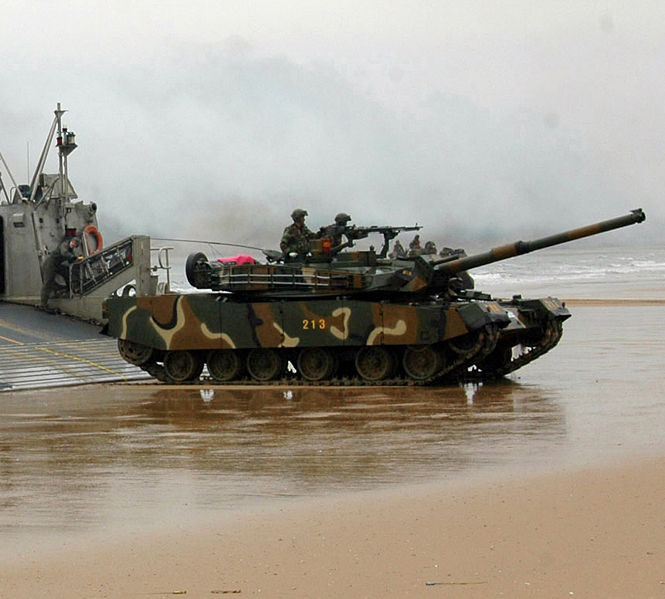 K1 of the South Korean marines landing
K1 of the South Korean marines landing
Design
Protection
The K1 hull and hexagonal turret are somewhat identical to the XM1 Abrams, with the same highly sloped beak and nearly flat upper glacis nose, subtle recline to the rear, a two-step hull with the rear engine compartment raised, and the drivetrain protected by removable, rigid side skirts for protection against RPGs. Over the RHA steel core of the hull and turret are welded compartments for the composite layers, of classified composition. These were the Special Armour Plate (SAP). The technology and composition are closely related to the Abrams armor, itself a development of the British Chobham-II, which put the emphasis on HEAT and APFSDS rounds protection.The turret sides receive Korean-designed storage panniers which also acted as extra BAR armor against RPGs. Active protection comprises a laser warning system and two 6-tubes launchers installed on the front section of the turret, firing smoke and IR projectiles as well as frag grenades. Protection will be later upgraded to the K2 level in the 2010s. The crew compartment had an air conditioning system but no collective NBC or overpressure, forcing the crew to wear a special gear in case of a contaminated environment. The automatic fire extinguisher relied on an optical sensor in the crew compartment and thermocouple wire in the engine compartment.
Mobility
Instead of the gargantuan 1,500 hp Honeywell AGT1500C turbine-coupled chosen for the Abrams, the K1 prototypes relied on the proven, smaller and less fuel-hungry 1,200 hp Teledyne Continental AVCR-1790, which take all advantage of the 51 tons of the initial design (versus 55 on the XM1). It was soon upgraded to the MTU MB Ka-501, the compact version of the 1,500 hp MB-873 Ka-503 that propelled the Leopard 2 for mass production. The exhaust grilles were also similar to the leopard. The transmission chosen was the ZF LSG 3000 (four forward, two reverse gears). Thanks to this, the power-to-weight ratio was 23.4 hp/ton and the vehicle could cruise at 65 kph on flat or 40 kph cross country. It could climb a 60% grade, 30% side slope, 1 m vertical step, 2.74 m trench, ford 1.2 m unprepared and 2.2 m with preparation. The drivetrain comprised six roadwheels per side, and the suspension system was more advanced than the XM1: It relied on a hybrid system consisting of hydropneumatic units for the first, second and sixth roadwheels while the others rested on torsion bars. Thanks to this, the hull elevation was +20 degrees and depression -9.7 degrees, allowing an optimized hull-down position, and extra elevation/depression for the main gun.Daewoo K6 DN-SD 12.7 mm heavy machine gun in action
Firepower
The KM68A1 105 mm rifled fully-stabilized cannon was the main armament, manually loaded with 47 rounds stored in the turret pannier and hull, with rear reloading hatches and safety blow-off panels. The secondary armament comprised a heavy 12.7 mm K6 HMG installed on the right pintle mount for the commander, a 7.62 mm M60D on the left pintle mount for the loader and an extra auxiliary 7.62 mm M60E2-1 on coaxial mount. The ammunitions were Korean, comprising the same array seen in NATO L7 guns, HE, Frag, HEAT, APFSDS among others. The modern fire control system was replaced on production model by one similar to the one used by German Leopards which provides a first round hit probability greater than 90% in all weather and conditions. However, it should be noted that the commander did not have a thermal visions device and had to rely on night vision goggles. This was corrected later on the K1A1. The Gunner's Primary Tank Thermal Sights (GPTTS) from Texas Instruments replaced the initial Hugues system for production. It had an integrated CO2-based laser, less harmful for the user's eye than the former Nd:YAG.The K1
The K1 was produced from 1987 to 1998 to 1,027 tanks at the Hyundai's automated production facility at Changwong, peaking at 100 per year at a unit price tag of 2,500,000,000 ₩ (won). Gradual improvements were performed on a prototype which will lead eventually to the K1A1. The K1M was a proposed export variant for Malaysia developed in 1997, including a laser warning system and an air conditioning unit, weighing 49.7 tons but Malaysia turned to the Polish PT-91M instead in 2003. The K1 PIP included the KSAP protection level, GPTTS and CO2 laser rangefinder. In 2013 the most important upgrade level was the K1E1 which conversion/production began in December 2013 (first released on July 7, 2014), similar to the K1A2 level, itself based on the K2 Black Panther. The full upgrade for all K1s in service is scheduled for 2026.The K1A1
The next iteration and all-out improvement of the K1 was the K1A1. Its development ended in 1996 when the first one was produced on April 3. It entered service in 2001. Its main difference was the locally license-built KM256 smoothbore 120 mm main gun based on the M256/Rheinmetall L44. The fire control system, laser rangefinder, thermal sights, turret and gun stabilization systems were all greatly improved. Protection was also greatly improved with the new Korean Special Armour Plate (KSAP). The commander panoramic thermal sight specs were as follows: 3x/10x day & night magnification, +/- 35˚ vertical, 360˚ horizontal, and 8° for the Gunner's alternate sight zoom. The carbon dioxide laser Range was 200 to 7,990 m, with a 1x/10x day, and 3x/10x night magnification. The turret shape is modified, alongside the new gun that has a thicker thermal sleeve, the co-axial machine-gun is higher in the front section of the turret, and a differently cone-shaped day/night KGPS. The overall weight was now 53.2 metric ton, and performances slightly decreased. The K1A1 is also much costlier (double) at 4,400,000,000 wons or approximatively 4,030,853 USD; So far only 484 (included the much-upgraded K1A2) have been cranked up until 2010. Upgrade to the A2 level are scheduled until 2022.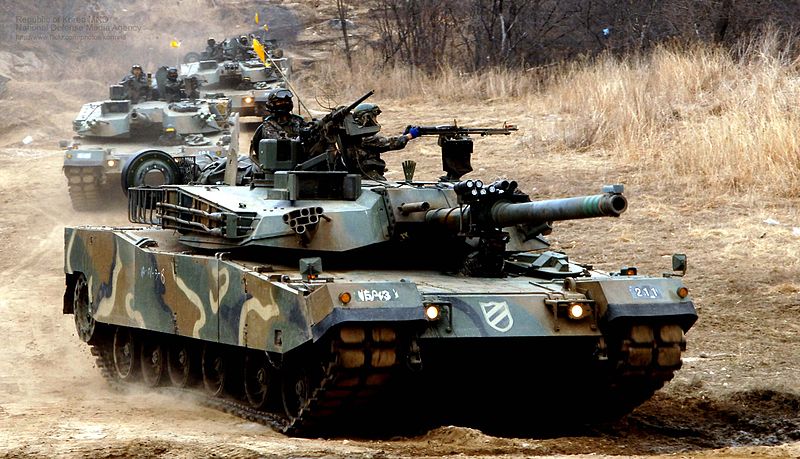 K1A1 in the 2013 11th armoured division field training exercises
K1A1 in the 2013 11th armoured division field training exercises
The K1A2
This version appeared at the same time as the K1E1 upgrade for the K1 and owns a big deal to the K2 Black Panther. It was derived from the K1A1 PIP and developed from 2008 to 2010, while production began in 2012. The hull was fitted with buoyancy tubes, there was an automatic command control system comprising IFF identification, satellite navigation and INS positioning systems, digital wireless communications and digital displays for the crew, with enhanced battlefield awareness. The air conditioning was improved and a soft-kill active protection system was fitted against missiles and rockets. The A2 will be the upgrade level for all previously built A1 until 2022.The K2 Black Panther
This state-of-the-art 3rd generation MBT was developed initially in 1995 by South Korean Agency for Defense Development to produce a dully domestic tank and therefore give away the licensing production problems which forbade export. After the German-designed 140 mm smoothbore was studied, a 120 mm/L55 was chosen instead. The powerplant was a Doosan Infracore Corporation 1500 hp supercharged diesel coupled to a local S&T Dynamics transmission but delays occurred in such a manner that the first 100 delivered were provisionally equipped with the same MTU that propelled the K1. After a US$230 million budget program, the development was sanctioned by a production start in March 2007 in Changwon. It was publicly revealed at DX Korea 2014. The unit price tag is fixed to 8.5 million US Dollars, making it one of the costliest MBT ever.Variants
It should be noted that the K1 was given a similar kit used on the Abrams, with a hydraulic dozer blade. Alongside specialized variants were built like the K1 Armored Recovery Vehicle fitted with a crane, winch and fixed dozer blade. The kit was designed and produced by Krupp MaK Maschinenbau GmbH/Rheinmetall Landsysteme GmbH between 1988 and 1992 and first deployed in 1993. The bridgelayer is the K1 Armoured Vehicle-Launched Bridge operating a scissor-type bridge system mounted on the chassis, developed in 1988-1992 with help from Vickers Defense Systems.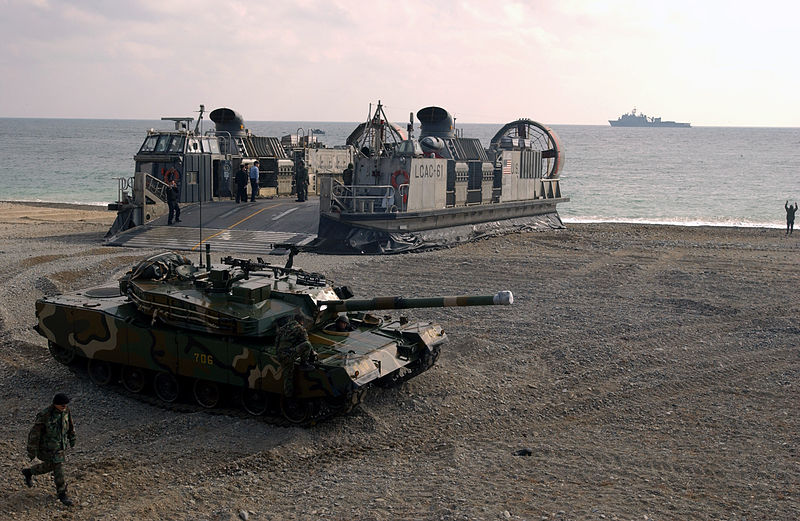 K1 MBT in joint US naval manoeuvers just laded off a USMC LCAC
K1 MBT in joint US naval manoeuvers just laded off a USMC LCAC
The K1 88 in service
The K1 was publicly revealed in 1987 when foreign journalists were invited to the unveiling ceremony followed by a massive training exercise for publicity. Upon entering service with the Marines and Grounds Forces of South Korea, a few gun accidents were noted. The latest occurred in 2010 due to a faulty loading manipulation during a live firing exercise at Paju. Procedures were modified accordingly but there was no fatality registered since. The K1 has been never engaged in any military foreign operations yet.Links
The K1 88 on wikipedia On globalsecurity.org
K1-88 specifications |
|
| Dimensions (l-w-h): | 9.67 oa x 3.60 x 2.25 m (29.5 x 9.84 x 6.5 in) |
| Total weight, battle ready: | 51.1 Tons (102,200 ibs) |
| Crew : | 4 (commander, gunner, loader, driver) |
| Propulsion: | 8-cyl. wc diesel MTU 871 Ka-501 1200 hp (890 kW) @2600 rpm and 23.4 hp/ton |
| Suspensions: | Torsion arms and hydro-pneumatic units |
| Top Speed | 65 kph (40 mph) 40 kph off-road |
| Range (road) | 500 km (280 mi) |
| Armament (K1) | Main: 105 mm KM68A1 (47 rounds) Sec: 12.7 mm K6 HMG, 7.62 mm M60D roof, M60E2-1 coaxial |
| Armour | Classified, composite, Chobham-based. |
| Production (K1 only) | 1,027 |
Gallery
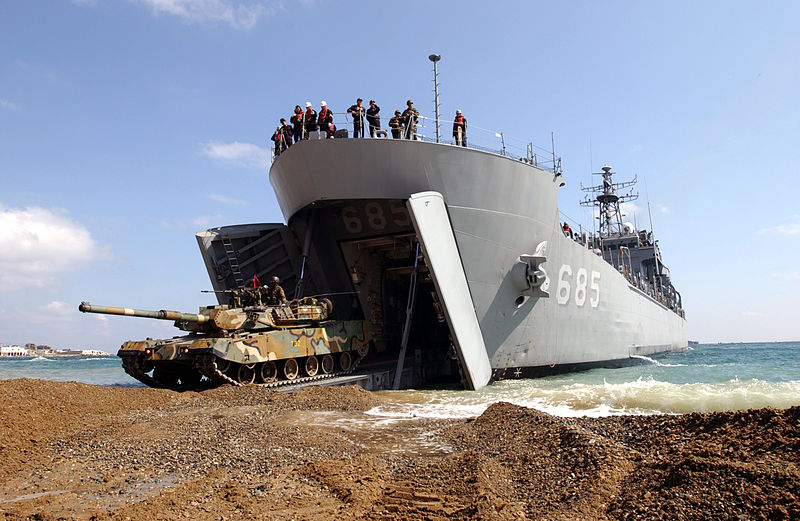
A Republic of Korea Tank drives off a Korean Amphibious Ship
South Korean Marines Forces Type-88K1
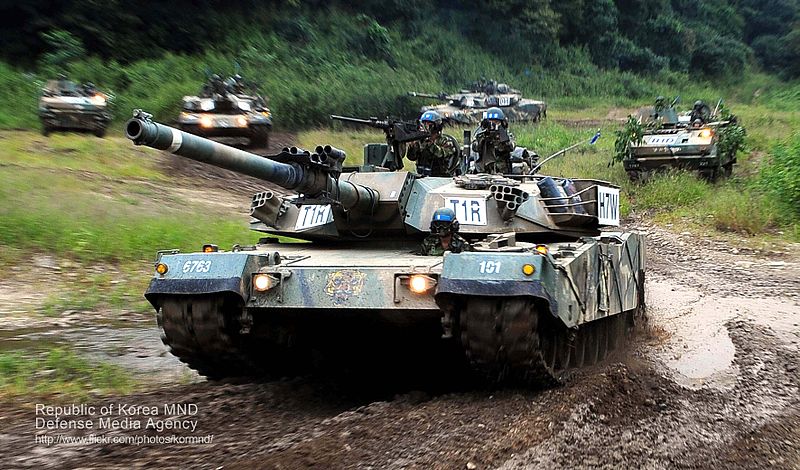
Rep. of Korea Army 2nd Armored Brigade 2012 K1A1 exercises.

K1 88 initial production model, 1986
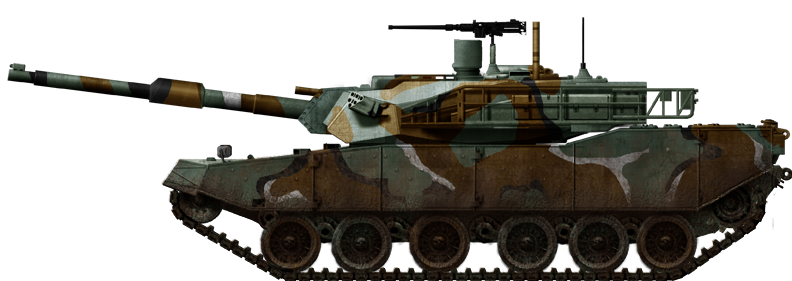
Up-armoured k1 88

K1-88 late production in winter manoeuvers
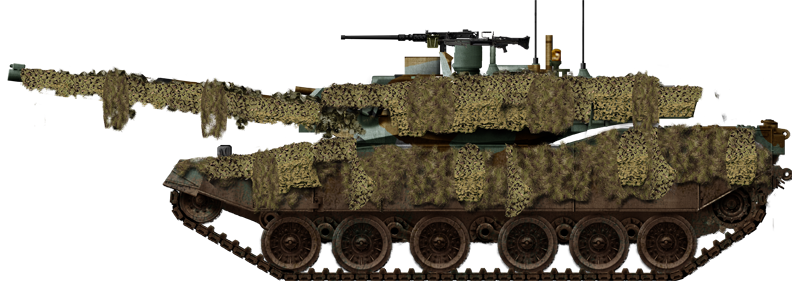
Camouflaged K1A1 88 in exercises

Cold War Tanks


































Cold war tanks posters

Cold War Main Battle Tanks

Cold War Soviet Army
Museums, Movies, Books & Games
The Tanks and Armor in pop culture
Tanks and armored vehicles in general are only really grasped when seen first person: The mass, the scale, it's all there. Explore also the way tanks were covered in the movie industry, in books and in video games.Movies:
Best tanks movie on warhistoryonline.com
On imdb.com
On bestsimilar.com/
miltours.com
liveabout.com/
watchmojo.com
Video Games:
pcgamesn.com
historyhit.com
levvvel.com
vg247.com/best-tank-games
mmobomb.com/
alienwarearena.com

